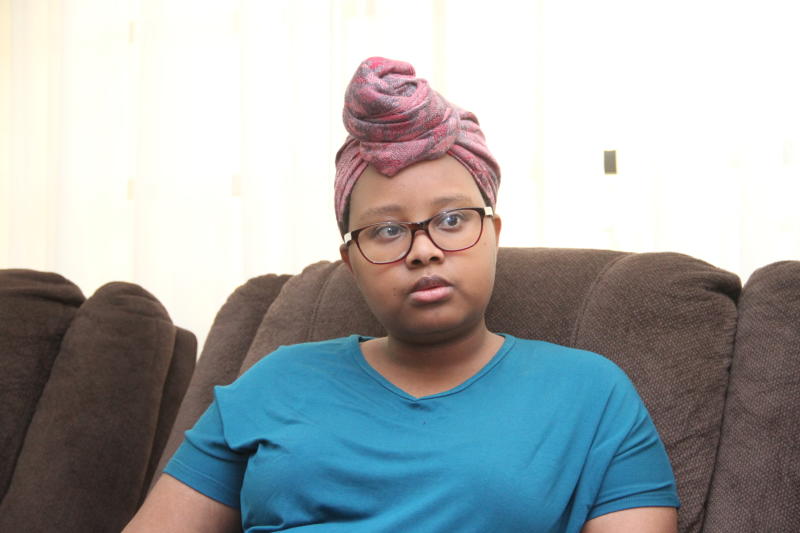In 2007, I was told I had a disease I had never heard of. It started with my knee popping out of place as I climbed on my bed. When I went to the hospital the following day, it snapped back into position as a doctor examined me.
I had another dislocation in the same place in 2009 as I bent down to pick up a bag. I had several other dislocations after which the leg would snap back into position.
My parents took me to a hospital in Nairobi in 2010 to find out what the problem with my knee was. An orthopedic surgeon said the thigh muscles that held my kneecap in place were faulty. He explained that two of these muscles were too weak while the other two were too strong and that strong muscles were taking advantage of the weak ones. I had a surgery at the hospital to strengthen the weak muscles and to weaken the strong ones.
I had another dislocation in school, just as I prepared to sit my final examinations. I was experiencing severe pain in my hip and an MRI in hospital revealed that I had a torn meniscus (the piece of cartilage that provides cushion between the thighbone and the shinbone). Doctors said that I needed a 30-minute surgery to repair the damage. The 30 minutes, however, became hours and I passed out during the surgery. When I woke up, I was in a lot of pain and I wasn’t feeling any better two days later when I left the hospital. The pain started in my right toe and spread to the ankle, knee, hip and then to my back and neck. I also started feeling it in my left leg and to the other parts of my body. It was a pain I couldn’t explain to anyone. I had an MRI of the spine that revealed my spine was okay.
Between January and July in 2010, I had consultations with more than 10 medical specialists in Kenya. I saw pediatricians, rheumatologists, neurologists and many other specialists. None of them told me why I was having the pain. Most said the pain was all in the head and that I was feigning it to avoid school. I found this ironic since I loved school. Another one said I had emotional issues and suggested that I see a psychiatrist. My parents forced my doctors to write me a recommendation to seek treatment in India.
My health had plunged by the time we decided to go to India. I had terrible insomnia and I would go for an entire week without sleep. I had developed irregular periods and painful cramps and I bled heavily up to three times a month. I had terrible blotting and constipation and I would go for a week without passing stool. Basically, my digestive, reproductive and even endocrine systems were failing. In India, I saw seven different specialists and the tests that came out revealed that I had fibromyalgia, a condition where the brain amplifies pain. Doctors prescribed medication and physiotherapy to rehabilitate my knee. For the first time in months, I slept heavily without any pain. Having been away from school for a long time, I repeated Third Form in 2013 in a day school where my parents kept monitoring my health. But the pain in my head came back in 2014 and I missed school for nearly the whole of second and third terms. My mother supervised my mock exams from the house and I remember writing my KCSE exams on a stretcher. I remember being wheeled to Nairobi Hospital after every paper to receive a jab that sustained me through the next paper. I consider it a miracle that I managed an A- in those exams.
I suffered another knee dislocation in 2015 during my first week in university at CUEA. And in 2017, I was rushed to hospital with severe pain in my abdomen. Doctors found menstrual tissue growing behind my uterus and concluded I had endometriosis.
Since last year, I have been in and out of hospital being treated for one complication or the other. I also started having painful spasms in my legs that would last for hours. And up to March this year, I was battling migraines that couldn’t go away with the strongest painkillers. But in August last year, I met a neurologist who said he knew a headache specialist in London. The doctor does botox, a kind of treatment for migraines, muscular disorders and a set of other disorders. It took us months to secure an appointment with the headache specialist. He in turn referred me to a hypermobility specialist who, after listening to my story, said I had EDS, a collection of symptoms and syndromes that couldn’t be treated holistically. He said most EDS syndromes each needed a specific treatment and management option.
I started my botox injections in March and had another one in June. The first two were trial injections to gauge how my body responded to the treatment. I had another one in August and I have to go for them in London once every three months for an entire year. After this, doctors will evaluate how my body is responding to treatment and determine whether or not I will need to proceed with the treatment. From the onset of the injections, the migraines have reduced significantly. But I am still battling the painful spasms in my legs which have no treatment. I also experience fatigue that turns into actual body ache. The other day, my face was so painful I could neither talk nor chew. I haven’t left the house since August when I flew in from London because of the fatigue. For people with the fibromyalgia and other conditions related to EDS, pain is a constant source of mood swings and even depression. I also appreciate the fact that I have a caring family that has had to adjust their schedules to my lifestyle to make me comfortable. Like my mother who quit employment and became my primary caregiver.
What you need to know about EDS
Ehlers-Danlos syndrome (EDS) is a group of disorders that affect the body’s connective tissues, primarily the skin, joints and blood vessel walls.
People with EDS have an increased range of joint movement or joint hypermobility, stretchy skin and fragile skin that breaks or bruises easily.
A more severe form of the disorder, called Ehlers-Danlos syndrome, vascular type, can cause the walls of your blood vessels, intestines or uterus to rupture.
Causes
Different types of Ehlers-Danlos syndrome are associated with a variety of genetic causes, some of which are inherited and passed on from parent to child.
Stay informed. Subscribe to our newsletter
Symptoms of EDS
· Overly flexible joints, stretchy skin and fragile joints
· Joint pain and clicking joints
· Extreme tiredness (fatigue)
· Skin that bruises easily
· Digestive problems, such as heartburn and constipation
· Dizziness and an increased heart rate after standing up
· Problems with internal organs, such as mitral valve prolapse or organ prolapse
· Problems with bladder control
Treatment
There’s no specific treatment for EDS, but it’s possible to manage many of the symptoms with support and advice.
Management options include
· Medication to control pain, blood pressure and other distinct diseases
· Physical therapy for weak joints
· Surgeries to correct damaged tissue
 The Standard Group Plc is a
multi-media organization with investments in media platforms spanning newspaper
print operations, television, radio broadcasting, digital and online services. The
Standard Group is recognized as a leading multi-media house in Kenya with a key
influence in matters of national and international interest.
The Standard Group Plc is a
multi-media organization with investments in media platforms spanning newspaper
print operations, television, radio broadcasting, digital and online services. The
Standard Group is recognized as a leading multi-media house in Kenya with a key
influence in matters of national and international interest.
 The Standard Group Plc is a
multi-media organization with investments in media platforms spanning newspaper
print operations, television, radio broadcasting, digital and online services. The
Standard Group is recognized as a leading multi-media house in Kenya with a key
influence in matters of national and international interest.
The Standard Group Plc is a
multi-media organization with investments in media platforms spanning newspaper
print operations, television, radio broadcasting, digital and online services. The
Standard Group is recognized as a leading multi-media house in Kenya with a key
influence in matters of national and international interest.






